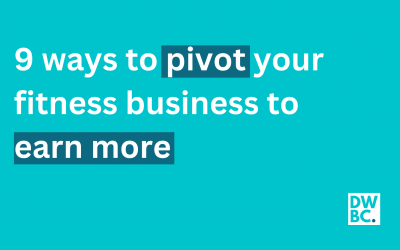We’ve got a very big problem with online fitness programming.
What looked like the dream side hustle for personal trainers hasn’t lived up to the hype.
It promised the world.
The dream was clear.
A lifestyle business where cashed-up PTs can spend the morning sitting with their laptop on a beach in Bali, leaving them the afternoon to sip ice cold kombucha and attend yoga retreats.
It was supposed to be the perfect lifestyle for young mums to make a couple of grand a week while their kids were at school – still leaving time for a latte with the girls.
Twenty-something gym-junkie fitness professionals came flocking. They had aspirations of working a couple of hours every morning over a plate of smashed avo on toast. A high-profit, low effort side hustle that fuelled their addiction to bench press and hip thrusts – all while giving them the holy grail… financial freedom.
I have SO many Fitness Professionals who come to me with failing online businesses – looking for mentorship and support to ‘fix’ their online business.
So what went wrong?
Why hasn’t the dream come true?
(Spoiler alert, the dream isn’t dead – and there IS a way to be a highly successful online programmer… but it’s going to require you to take some very specific steps – more on that soon…).
To understand where we’re all going wrong, we need to venture into our natural habitat… the gym.
For a moment, let’s move away from the online space and talk about physical sessions. It’ll help us understand why online programming hasn’t been what we hoped, and how to fix it.
Most gyms have a handful of Personal Trainers. And as with any profession, the cream rises to the top. The best PTs get the best results for their clients, and offer the best experience. They become so good, that it’s hard for people to ignore them. They get more clients, raise their prices (supply and demand), become more exclusive, get busier, raise their prices, create scarcity, and so the cycle goes. To quote the titles of two of my favourite business books – ‘be so good they can’t ignore you’ and ‘someone has to be the most expensive, why not make it you?’
It’s a recipe for success.
The best PTs in the local gym get busy and get their pick of the clients.
But the local gym is a small pond, so let’s zoom out and think bigger. People start to talk, and the ‘big fish’ in the local gym start to become known in the community. They build a reputation for the experience they provide, and people start to travel further to get a piece of this experience. But now the competition is stiffer, there are more PTs for the market to choose from. Competition increases, and it’s harder to be the best.
But the good news is, people will only travel so far for Personal Training. They’re not going to drive across town to see a PT, even if she’s the best. So when they find someone who’s ‘good enough’, they’ll probably hang around. A ‘good enough’ PT that’s geographically convenient (close to home or work), will win out over ‘the best’ PT who’s an hour away.
If you’re just a big fish in a small pond, the market will let you off the hook. You’re good enough, because your competition (other PTs) is finite – your potential clients don’t have as many people to compare you to.
Things take a worrying turn though when it comes to online programming. Where PTs were once rescued by geographical constraints and how far people were willing to travel, the internet has no boundaries, and infinite reach.
We can make some rough calculations and calculate the total number of Personal Trainers worldwide with internet access to be around 200,000.
That’s slightly more than the six PTs operating out of your local 24 hour gym.
And this is your competition. Not just the PTs in your gym. Not just the PTs in your suburb or city. But every PT on Earth. All of them.
Being the best out of six isn’t hard. Being the best out of 200,000 is basically impossible.
And that right there is the problem. And there are some solutions – which I’ll get to soon.
But first, the news gets worse.
Unlike the competition at your local gym, who only has so many hours for face-to-face PT sessions, generic online programming has almost infinite scaleability. Take 19 year old PT Steve. He skips leg day, watches TikTok videos while training clients, and uses way too much Lynx Africa. And even he can get clients, because once the other trainers are at capacity, new leads overflow to him.
There’s a key word there… capacity. Even the best PT in town only has so many hours in a day. There’s a ceiling on the number of sessions they can run, so you don’t even have to be good to make a semi decent living as a PT. You just have to turn up.
But the online space isn’t like that. Instead of finite capacity, the capacity of online programming is infinite. It’s as easy to assign 10,000 people a generic program as it is to assign that same program to one.
So you won’t be saved by geography, and you won’t be saved by operational capacity.
I’ve got more bad news for you. Even being the best isn’t enough. You also have to be rich. And famous.
You know who’s really rich and really famous?
Chris Hemsworth.
Yep, you’re in competition with Thor, the god of thunder, and People Magazine’s ‘sexiest man alive’.
Hemsworth founded his online programming fitness app, Centr, in 2019, and his 57 million Instagram followers loved it. Just three years later, Centr was acquired by New York-based investment group HighPost Capital – a group lead by Mark Bezos, the brother of the world’s third richest person, Jeff Bezos.
Conservative estimates put the current value of the app at around $250 million. That’s quarter of a billion dollars… and that’s what you’re competing with.
Tens of millions of Instagram followers, and hundreds of millions of dollars.
That’s a hard race to win.
And these are the core reasons that online programming hasn’t delivered the financially free lifestyle business you were hoping for. Infinite competition, infinite quality, infinite finances, infinite fame, infinite scaleability.
That’s what you’re up against.
Peter Diamandis, thought leader, marketer, engineer, physician and entrepreneur talks about ‘six Ds’ of exponential organisations, which describe the transformational pattern that companies go through as they become digitised.
And while this transition accelerates rates of progress, it can pose further problems for online programmers.
The six Ds are Digitalisation, Deception, Disruption, Demonetisation, Dematerialisation and Democratisation.
Three of these are particularly relevant to PTs who are looking to create an online programming business.
Digitalisation means that traditional gym-based workouts are transformed into formats that are accessible on digital devices. This allows users to access a wide range of fitness routines anytime, anywhere.
Disruption means that by offering a convenient alternative to gym memberships and in-person training sessions, online exercise programs disrupt the traditional fitness industry. They provide personalised, on-demand workouts that often undercut the cost of traditional fitness services, making them increasingly popular and causing a significant shift in consumer behaviour. Not only does this increase the competition between online programmers, but it can cannibalise in-person training, meaning that even face-to-face personal training is at risk of increased competition from online programming.
And democratisation means that high-quality fitness training becomes more accessible to a broader audience, irrespective of geographic location or socioeconomic status. As long as users have internet access, they can benefit from expert training that might otherwise be too costly or difficult to access, democratising health and fitness.
But amidst all this doom and gloom, there is a way.
There are things you can do to make the online programming option not only work, but deliver the lifestyle business you’ve dreamed of. I built my online programming business to generating over $2,000 profit per week – about $110,000 (before tax) per year. And while that will never be mentioned in the same sentence as Chris Hemsworth’s successes, it’s a pretty handy little ‘side hustle’ that topped up the income from my core businesses, paid me over $250 an hour, and delivered geographical freedom.
Here’s how you can make it work.
In fact, there are four ways: Being unique. Doing things that don’t scale. Being tool agnostic. And being small.
Let’s unpack each of these, starting with being unique.
One of the very first things I work on with the business owners I mentor is their USP – unique selling proposition. I ask them what makes them special. What makes them different? Why do people work with them instead of someone else?
What makes them unique?
It’s said that you either need to be ten times better than your competition, or you need to be different. And it’s much easier to be different than it is to be ten times better.
So how can you make your online programming business unique? There are two ways. You can provide a unique experience – maybe something like a program that combines swimming with kettlebells in one session. Or you can cater for a unique avatar – maybe you program exclusively for people with shoulder injuries, combining rehabilitation with strength and conditioning where you program around the limitations of someone with an injured shoulder.
Now of course, there aren’t many people who want to follow a swimming/kettlebell program, but remember, the online nature of the programming means you’re not confined by geography.
So what’s your niche? It needs to be either a niche service, or it needs to target a niche client.
Be unique, that’s the first thing you can do to make online programming work.
The second thing you can do is to do things that don’t scale. Remember, you’re competing with people with deep pockets and massive reach – two things you probably don’t have. These people can credit their success to the scalability of their program. They can spend a very small amount of resources (time and money) to reach a lot of people. Small investment, large payout. And because they’re playing a volume game, they can charge people a couple of bucks a week and still make a killing.
Without unlimited money and influence, you can’t compete by being more scaleable than your opposition.
So you need to flip the script. You need to do things that don’t scale.
The good news is, if you’re doing unscalable things, you’re no longer competing with the big players.
In 2013, Paul Graham, the founder of the Silicone Valley start-up incubator, Y-Combinator wrote a landmark article, “Do Things That Don’t Scale”.
In this article, he talks about the reliance a lot of start-up founders have on scaleable tasks, but that often, you need to start a business with non-scaleable tasks.
I’m suggesting that your online programming business should not only start with non-scaleable tasks, but continue with them.
You can play with strategies like ultra individualised programming, weekly check-in phone calls, daily video analyses of movements, monthly face-to-face sessions, attendance at Physio appointments, video calls to explain the week’s programming, assistance with online food shopping etc.
And while you lose out on the infinite scaleability, the big advantage is that you’re no longer playing the volume game and relying on hundreds or thousands of low paying clients to make your business financially viable. You can be highly successful with much fewer people, meaning you’re not competing with an app that has its own marketing department.
And because you’re offering an experience that the Chris Hemsworths of the world can’t replicate and scale, you’re no longer competing with them, and you can charge a premium price. Instead of racing to the bottom, you’re racing to the top. With 30 clients, you can pull in a six figure income.
So, tip one was to be unique, and two was to do things that don’t scale.
The third strategy you can use is to be ‘tool agnostic’… but what does this mean?
It means that you haven’t fallen in love with a certain way of doing things. There’s a concept called ‘Maslow’s Hammer’, which states that if the only tool you have is a hammer, every job looks like a nail. Need to saw a piece of wood? Hit it with a hammer. Got a broken window? Hit it with a hammer.
If you go to a surgeon for your dodgy knee, she’s probably going to recommend surgery. Surgery is her hammer.
So how does this help us build an online business?
Instead of falling in love with the idea of online programming, go back to base principles and ask yourself what it is that your target clients need. What are the problems they need your help in solving?
Because ultimately, every successful business is successful because they solve problems.
Let’s say your target client is a busy, time poor, white collar professional. You can solve their problems by being flexible and convenient. And sure, online programming is one way to do this, but not the only way. Maybe you can combine online programming with face-to-face sessions. Maybe you can do home visits and provide the equipment. Maybe you can train them in the gym where they work. Maybe virtual training over video calls will solve their problems.
Get creative. Ask yourself what their problems are, and come up with novel ways to solve them. Sure, online programming is part of the puzzle, but it’s not the only piece.
So, we know you need to be unique, do things that don’t scale and be tool agnostic.
The final strategy is to be small – to intentionally choose to work with only a small number of clients.
‘Who are these clients’ you ask?
They are people who know, like and trust you.
It doesn’t matter how famous or handsome your competition is, there’s no way they can compete with deep, meaningful relationships you’ve fostered over years. These relationships give you a level of trust that can’t be matched.
And ultimately, if people know, like and trust you, they know you’ll have your best interests at heart and be the best person for the job.
Using this ‘stay small’ model, it will be easy for you to get clients, because you already know them. Marketing (which is often the biggest challenge for fitness professionals) becomes quite easy.
I’ll level with you. It’s really hard to build a massive stable of online programming clients, but it’s relatively easy to quickly build a small stable.
And to really succeed, you need to combine this intimate group of clients with the other strategies we’ve discussed.
You need to offer a unique service or target a narrow niche. You need to do things that won’t scale. You need to explore different ways of solving the problems of your clients (not just online programming). And you need to do this for a small group of people who know, like and trust you.
If you can do those things, you can charge a premium price, and potentially even build that online programming lifestyle business that has promised so much but delivered so little.
Need help? Maybe I can provide it.





